
Ceviche, cebiche, sebiche, or seviche is a dish consisting of fish or shellfish marinated in citrus and seasonings, and is recognized by UNESCO as an expression of Peruvian traditional cuisine and Intangible Cultural Heritage of Humanity. Different versions of ceviche are part of the culinary culture of various Spanish-American countries along the Pacific Ocean where each one is native: Chile, Colombia, Costa Rica, Ecuador, El Salvador, Guatemala, Honduras, Mexico, Nicaragua, Panama and Peru. In Peru it is also considered a flagship dish and cultural heritage.
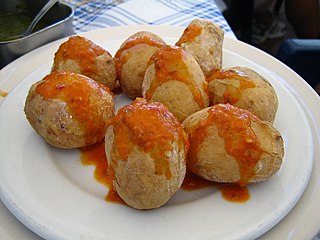
Mojo is the name, or abbreviated name, of several types of sauces, varying in spiciness, consisting primarily of olive oil, local pepper varieties, garlic, paprika, cumin or coriander, and other spices. Mojo originated in the Canary Islands, where the main varieties are green mojo, red mojo, and spicy red mojo. Other countries have recipes similar to mojo, where acidic ingredients such as vinegar, lemon, orange, or lime juice may be used.
Sweet and sour is a generic term that encompasses many styles of sauce, cuisine, and cooking methods. It is commonly used in East Asia and Southeast Asia and has been used in England since the Middle Ages. Sweet and sour sauce remains popular in Asian and Western cuisines.
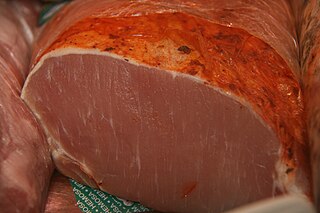
Adobo or adobar is the immersion of food in a stock composed variously of paprika, oregano, salt, garlic, and vinegar to preserve and enhance its flavor. The Portuguese variant is known as carne de vinha d'alhos. The practice, native to Iberia, was widely adopted in Latin America, as well as Spanish and Portuguese colonies in Africa and Asia.

Filipino cuisine is composed of the cuisines of more than a hundred distinct ethnolinguistic groups found throughout the Philippine archipelago. A majority of mainstream Filipino dishes that compose Filipino cuisine are from the food traditions of various ethnolinguistic groups and tribes of the archipelago, including the Ilocano, Pangasinan, Kapampangan, Tagalog, Bicolano, Visayan, Chavacano, and Maranao ethnolinguistic groups. The dishes associated with these groups evolved over the centuries from a largely indigenous base shared with maritime Southeast Asia with varied influences from Chinese, Spanish, and American cuisines, in line with the major waves of influence that had enriched the cultures of the archipelago, and adapted using indigenous ingredients to meet local preferences.
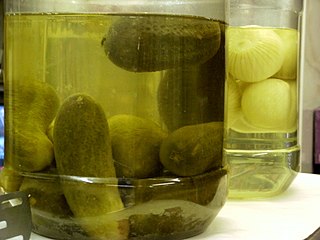
Pickling is the process of preserving or extending the shelf life of food by either anaerobic fermentation in brine or immersion in vinegar. The pickling procedure typically affects the food's texture and flavor. The resulting food is called a pickle, or, if named, the name is prefaced with the word "pickled". Foods that are pickled include vegetables, fruits, mushrooms, meats, fish, dairy and eggs.

The generic term for condiments in the Filipino cuisine is sawsawan. Unlike sauces in other Southeast Asian regions, most sawsawan are not prepared beforehand, but are assembled on the table according to the preferences of the diner.

Uruguayan cuisine is a fusion of cuisines from several European countries, especially of Mediterranean foods from Spain, Italy, Portugal and France. Other influences on the cuisine resulted from immigration from countries such as Germany and Scotland. Uruguayan gastronomy is a result of immigration, rather than local Amerindian cuisine, because of late-19th and early 20th century immigration waves of, mostly, Italians. Spanish influences are abundant: desserts like churros, flan, ensaimadas yoo (Catalan sweet bread), and alfajores were all brought from Spain. There are also various kinds of stews known as guisos or estofados, arroces, and fabada. All of the guisos and traditional pucheros (stews) are also of Spanish origin. Uruguayan preparations of fish, such as dried salt cod (bacalao), calamari, and octopus, originate from the Basque and Galician regions, and also Portugal. Due to its strong Italian tradition, all of the famous Italian pasta dishes are present in Uruguay including ravioli, lasagne, tortellini, fettuccine, and the traditional gnocchi. Although the pasta can be served with many sauces, there is one special sauce that was created by Uruguayans. Caruso sauce is a pasta sauce made from double cream, meat, onions, ham and mushrooms. It is very popular with sorrentinos and agnolotti. Additionally, there is Germanic influence in Uruguayan cuisine as well, particularly in sweet dishes. The pastries known as bizcochos are Germanic in origin: croissants, known as medialunas, are the most popular of these, and can be found in two varieties: butter- and lard-based. Also German in origin are the Berlinese known as bolas de fraile, and the rolls called piononos. The Biscochos were re-christened with local names given the difficult German phonology, and usually Uruguayanized by the addition of a dulce de leche filling. Even dishes like chucrut (sauerkraut) have also made it into mainstream Uruguayan dishes.

Kinilaw is a raw seafood dish and preparation method native to the Philippines. It is more accurately a cooking process that relies on vinegar and acidic fruit juices to denature the ingredients, rather than a dish, as it can also be used to prepare meat and vegetables. Kinilaw dishes are usually eaten as appetizers before a meal, or as finger food with alcoholic drinks. Kinilaw is also sometimes called kilawin, especially in the northern Philippines, but the term kilawin more commonly applies to a similar lightly grilled meat dish.
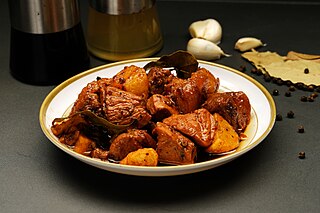
Philippine adobo is a popular Filipino dish and cooking process in Philippine cuisine. In its base form, meat, seafood, or vegetables are first browned in oil, and then marinated and simmered in vinegar, salt and/or soy sauce, and garlic. It has occasionally been considered the unofficial national dish in the Philippines.

Nanbanzuke or nanban-zuke is a Japanese fish dish. To prepare it, the small fish (Sprat) or diced fish is lightly dusted with potato starch or cornstarch and then deep fried until golden brown. It is then served in a hot broth made of grain vinegar, dashi, mirin, and shō-yu, with finely-sliced onion, finely julienne carrots, finely-shredded green peppers, and red chilli peppers. It bears a close resemblance to escabeche and is believed to have been brought to Japan by the Portuguese in the 16th century.

Inihaw, also known as sinugba or inasal, are various types of grilled or spit-roasted barbecue dishes from the Philippines. They are usually made from pork or chicken and are served on bamboo skewers or in small cubes with a soy sauce and vinegar-based dip. The term can also refer to any meat or seafood dish cooked and served in a similar way. Inihaw are commonly sold as street food and are eaten with white rice or rice cooked in coconut leaves (pusô). Inihaw is also commonly referred to as Filipino barbecue or (informally) Pinoy BBQ.

Chicken inasal, commonly known simply as inasal, is a variant of the Filipino chicken dish known as lechon manok. Chicken inasal is a grilled chicken part usually breast (Pecho) or leg (Paa) while a lechon manok is a stuffed whole chicken. It is chicken marinated in a mixture of calamansi, pepper, coconut vinegar and annatto, then grilled over hot coals while basted with the marinade. It is served with rice, calamansi, soy sauce, chicken oil and vinegar.

Sarsiado is a fish dish from the Philippines which features tomatoes and eggs. The name sarsiado in the Tagalog language means "cooked with a thick sauce". The name is derived from the Filipino word sarsa which in turn is from the Spanish word salsa, which means "sauce".

Hot and sour soup is a popular example of Chinese cuisine. Although it is said to be originated in Sichuan, this is actually a variant of hulatang or "pepper hot soup" (胡辣汤) with added vinegar to enhance the sourness. This variation is found in Henan province, and in Henan cuisine itself. Also popular in Southeast Asia, India, Pakistan and the United States, it is a flexible soup which allows ingredients to be substituted or added depending on availability. For example, the American-Chinese version can be thicker as it commonly includes corn starch, whilst in Japan, sake is often added.

Afritada is a Philippine dish consisting of chicken, beef, or pork braised in tomato sauce with carrots, potatoes, and red and green bell peppers. It is served on white rice and is a common Filipino meal. It can also be cooked with seafood.

Pininyahang manok, commonly anglicized as pineapple chicken, is a Philippine dish consisting of chicken braised in a milk or coconut milk-based sauce with pineapples, carrots, potatoes, and bell peppers. Some variants of the dish use a chicken stock base instead of milk. The dish originates from Southern Luzon which was once a regional center of pineapple fiber production in the Spanish Philippines.
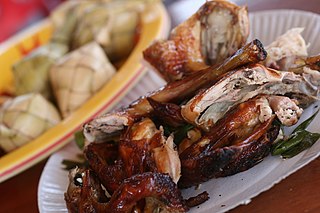
Lechon manok is a Filipino spit-roasted chicken dish made with chicken marinated in a mixture of garlic, bay leaf, onion, black pepper, soy sauce, and patis. The marinade may also be sweetened with muscovado or brown sugar. It is distinctively stuffed with tanglad (lemongrass) and roasted over charcoal. It is typically eaten dipped in a toyomansi or silimansi mixture of soy sauce, calamansi, and labuyo chilis. It is paired with white rice or puso and commonly served with atchara pickles as a side dish. It is a very popular dish in the Philippines and is readily available at roadside restaurants.



















